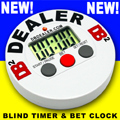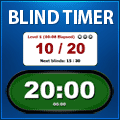|
|
One Chip Rule(Over-sized chip rule) If you put a single chip in the pot that is larger than the bet, but do not announce a raise, you are assumed to have only called. Example: In a $3-$6 game, when a player bets $6 and the next player puts a $25 chip in the pot without saying anything, that player has merely called the $6 bet. Robert's Rules of Poker - Betting and Raising Next to string-bets, the one chip rule (sometimes referred to as the over-sized chip rule) is probably one the least understood poker rules and can easily confuse new poker players in a casino. Simply put, a bet of one chip (or bill) is a call unless you verbally state otherwise. If you are facing a $5 bet and bet one $20 chip - that is a call of $5 and the dealer will refund you $15. if you intend to raise, you must verbally state "raise" before you release your chips or move them forward. On the first round, the opening bet made with one chip or bill on the first round is considered a call of the bring-in amount (big blind). On any succeeding round, the first bet is equal to the size of the one chip or bill, unless an announcement to the contrary is made. Please note that different poker rooms sometimes interpret the one-chip rule in different ways and that limit games and stud games are sometimes treated differently than no-limit games. The rules and examples on this page apply to no-limit hold'em games. ExamplesPlayer A bets $5 and Player B bets one $20 chip - call. Player A bets $5 and Player B bets one $500 chip - call. Player A bets $5 and Player B bets one $5 chip and one $1 chip - call (dealer refunds $1). Player A bets $5 and Player B bets one $5 chip and ten $1 chips - raise to $15. Player A bets $5 and Player B bets two $5 chips - raise to $10. Player A bets $5 and Player B bets one $5 chip and one $20 chip - raise to $25. Player A bets four $5 chips and Player B bets one $20 chip - call. Player A bets four $5 chips and Player B bets nine $5 chips - raise to $45. Player A bets $5 and Player B bets three $1 chips - call (Player B forfeits his $3 or adds another $2 to call. Player B cannot raise, since he has already called.).* * The last example brings up a situation that happens quite frequently in poker - a player who does not bet enough to call. In situations such as this the player either forfeits the chips that he bet or he places enough additional chips into the pot to make a call. Pay attention!You should always be aware of the current bet - not paying attention, or listening to your iPod can cause you problems. Let's say that the first player to act bets a $5 chip and the next player to act calls by throwing forward a $20 chip. You are wearing your iPod and Willie Nelson is drowning out the sound of the other players and the dealer. What is the amount of the bet to you? Is the bet $5 or is the bet $20? You have no idea and have to either ask (slowing down the game) or take a guess. Neither situation is acceptable. Multiple chip betThe opposite of the one-chip rule is a bet that includes enough chips to constitute a raise. Let's say that a player bets $5 and the next player throws forward five $20 chips without saying a word - that is a raise since only one $20 chip was needed to call the bet but the player threw five $20 chips forward. Since a bet cannot be retracted, the entire $100 (five $20 chips) is the new bet (a $95 raise). This rule can have a negative consequence if a player accidentally releases extra chips with his bet. In the above example, let's say that the second player to act intends to bet five $20 chips but when doing so, he has numerous other chips in his hand, over and above the five $20 chips. As the player releases the five $20 chips ... a $500 chip accidentally falls from his hand and lands on the table with his five $20 chips. That player has just bet $600! The $500 chip cannot be retracted. Sure, the $500 chip was not meant to be bet, but it was! Posting blindsOn a related note, it is quite common for the small blind or the big blind to post a blind with a chip that is higher than what is required for the blind. For example, the blinds are $5/$10, the small blind posts a blind of a single $5 chip but the big blind posts a blind of a $20 chip. In a situation such as this the dealer will often make change for the player before play begins but will sometimes wait until other players act on their hands - the dealer will then collect all the bets and hand the big blind his $10 in change. As a poker player, it is important to always be aware of the amount of the current bet. In a situation such as this, you might mistakenly assume that the bet is $20 but it is not - the bet is only $10. If you were to make a forward motion by throwing out four $5 chips, you have just raised the bet from $10 to $20. In many casinos, once you make your bet you cannot retract any portion of your bet so your entire $20 bet must play, although some poker rooms, or dealers, will allow you to retract a portion of your bet if it was obvious that you were confused.
See also: String bets, Betting help, All-in help |
Online Poker Guide
Hand Converter
Holdem strategy
Freeroll tournaments
Poker calculator
Online poker
Poker rooms
> poker pokeren
> iDeal poker
> online casino
> iDeal casino
> casino casinos
> casino bonus
Get Bonus code Titan Poker, and full tilt poker referral code or max bonus to the full tilt referral code. Best ultimate bet referral code sign up bonus doyles room promo code or poker host bonus code























